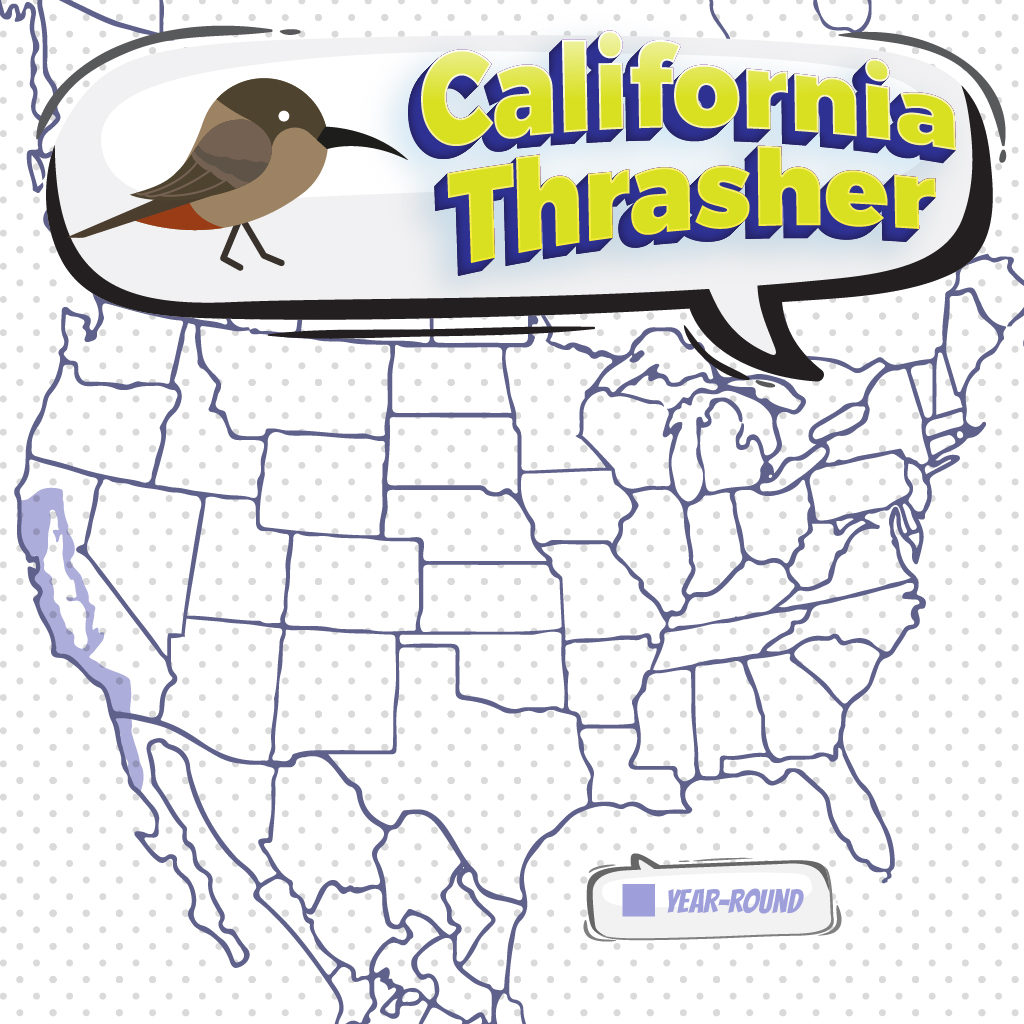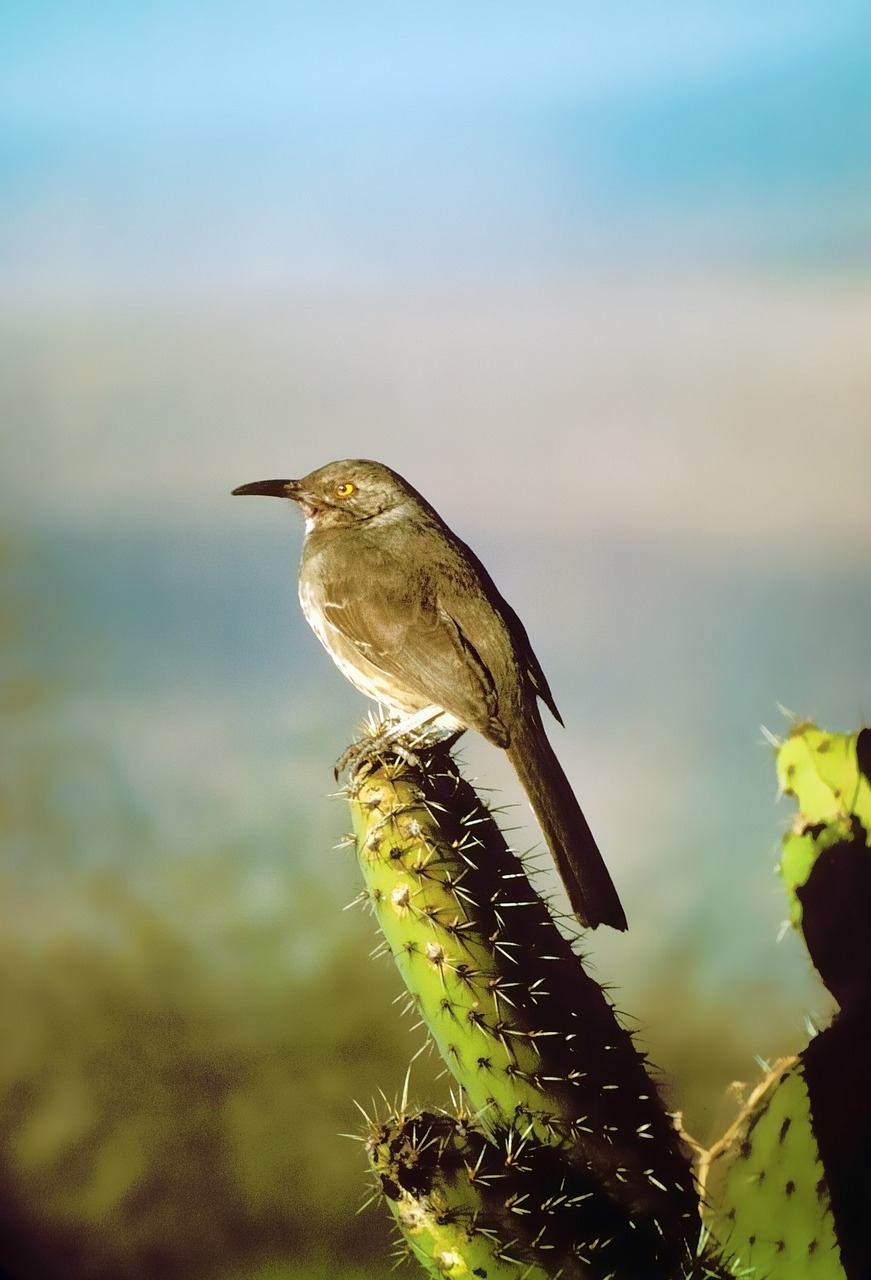
 California Thrasher
California Thrasher
A California Thrasher is a fun bird to see while bird watching. Below are some tips to help you identify California Thrashers. We have also put together a list of fun California Thrasher t-shirts, California Thrasher bird patches, bird houses, bird feeders, binoculars, stickers and other fun bird watching items.
About the California Thrasher
The California Thrasher is mainly found in California and Banja California. They are the largest of the thrasher species. Like most thrashers, they rarely fly in the open fields and prefer to hide under a dense bush. Therefore, it is hard to spot one. Some of their distinctive features include:
Description and Identification
California Thrashers are large songbirds with long tails and very long and deeply curved bills.
These birds have predominantly brown plumage, with the only variance in their coloration being
that their underparts are slightly lighter than their upperparts. They have white throats and dark
eyes. Both males and females look similar in appearance. Younglings can be distinguished from
the adults by the yellow bordering on the bottom of their wings, and brown bills in contrast to the
black bills the adult’s sport. The feet of the younglings are also lighter in color.
Some unique characteristics of California Thrashers include their grooming techniques and their
ability to sing. Unlike birds that commonly bathe in water or dust, California Thrashers approach ant
hill and let ants crawl over them. They terminate possible mites and lice by bathing in the formic
acid secreted by the ants. These birds are excellent singers which can easily mimic thousands of
sounds. A study that researched the singing ability of these birds found that there can be about
2800 phrases in their songs.
California Thrasher Color Pattern
California Thrashers have buff to orange-yellow underparts and dark olive-brown upperparts. Their eyes are brown with a brown crown. The pale gray tail corners sandwich the dark brown center feathers. Their cheeks display a dark cheek pattern and so do their eye-lines.
California Thrasher Size
These robin-sized birds have a long down-curved bill and a long tail.
Relative size for both sexes
- Length range: 12.6 in (32 cm)
- Weight: 2.8-3.3 oz (78-93 g)
- Wingspan range: 12.2 in (31 cm)
California Thrasher Behavior
They feed on the ground swinging their bill in a sideways pattern as they flip through the leaf litter or digging viciously. When disturbed they run for cover with their tail raised. They display long flights with shallow wing beats. When on the ground, they walk slowly but are able to cover long distances.
They are territorial birds and the males sing to protect their nest. They do this from treetops or shrubs. Their songs usually mimic other birds.
What California Thrasher Eat
California Thrashers have earned their name due to their distinctive manner of foraging for food.
They thrash through the mulch and leaves to find spiders, berries, insects, and seeds. They can also
use their bills to dig the soil or turn cow dung to find insects. Ants, wasps, bees, beetles, moths,
and caterpillars are the insects commonly eaten by these birds. Grains and plant materials are an
important source of food for these birds, and they are also known to approach bird feeders for any
scraps they can find.
California Thrashers primarily feed on insects and seeds. Can feed on a wide array of insects such as wasps, ants, beetles, moths, caterpillars, etc. You can also find them hunting for spiders. They supplement their diet with fruits, seeds, acorns, and other plant materials when available.
Where California Thrashers Live
Foothills, valley thickets, parks, and chaparrals are common habitats of California Thrashers. They
are common sights in lowland habitats with shrub thickets in their range. Chaparrals are their
favorite habitats, although they can be found in any low habitats that have a presence of
abundant vegetation.
Ideally, California Thrashers are found in lowland areas and chaparral. You can also spot them in riparian woodland thickets. It is common to hear them sing in parks and urban gardens.
Range and Migration

California Thrashers are large thrashers mostly found in California and Baja California. These birds
are the only thrashers found along the California coast. Although the range of these birds is very
limited, they are very abundantly found within that range. California Thrashers are permanent
residents who always stay close to their breeding areas.
California Thrasher Lifecycle
The females lay around 3-4 eggs, after which, the incubation is carried out by both parents for 14 days. During the nestling period, both parents feed the young ones. They later leave the nest after 12-14 days. The California Thrasher species can produce 2-3 broods per year. The females lay the first clutch around February or March, with the second following closely. Lifespan is between 6-9 years in the wild.
California Thrasher Nesting
California Thrashers are monogamous birds that equally participate in the entire breeding process.
The males chase the females to court them. Both members of the pair have been observed singing
during the early portions of the breeding cycles. Males and females both construct the nest
together out of various plant materials such as stems, bark, weeds, and forbs. The nests are
generally situated 7 feet off the ground and are aggressively protected by the parents. Females
lay and incubate about 1-6 eggs at a time. California Thrashers usually raise 2 broods a year, often
kicking out the younglings from the first brood when they prepare to nest for the second time.
During this period, males might provide the young birds with food if needed.
Ornithology
Bird Watching Academy & Camp Subscription Boxes
At Bird Watching Academy & Camp we help kids, youth, and adults get excited and involved in bird watching. We have several monthly subscription boxes that you can subscribe to. Our monthly subscription boxes help kids, youth, and adults learn about birds, bird watching, and bird conservation.
Bird Watching Binoculars for Identifying California Thrashers
The most common types of bird-watching binoculars for viewing California Thrashers are 8×21 binoculars and 10×42 binoculars. Bird Watching Academy & Camp sells really nice 8×21 binoculars and 10×42 binoculars. You can view and purchase them here.
California Thrasher T-shirts
If you love the California Thrasher you should purchase a Bird Watching Academy & Camp T-shirt. To help support bird conservation we donate 10 percent to bird conservation activities.
California Thrasher Iron On Patches
Kids, Youth, and Adults love to collect our Bird Watching Academy & Camp iron-on patches. Our bird-watching patches help you keep track of the birds you have seen and identified. You can also display the patches on our Bird Watching Academy & Camp banners.
The California Thrasher is a great iron-on patch to start your collection with. The patches are durable and can be sewn on or ironed on to just about anything.
California Thrasher Stickers
Stickers are a great way for you to display your love for bird watching and the California Thrasher. We sell a monthly subscription sticker pack. The sticker packs have 12 bird stickers. These sticker packs will help your kids learn new birds every month.
Bird Feeders For California Thrasher
There are many types of bird feeders. Here are our favorite bird feeders for your backyard. We use all of these bird feeders currently. Kids will have a great time watching birds eat at these bird feeders. Using this collection of bird feeders will provide a wide variety and many types of birds.
Best Bird Houses for California Thrasher
There are many types of birdhouses. Building a birdhouse is always fun but can be frustrating. These 4 birdhouses have become our favorites. Getting a birdhouse for kids to watch birds grow is always fun. We spent a little extra money on these birdhouses but they have been worth the higher price and look great.


 California Thrasher
California Thrasher







